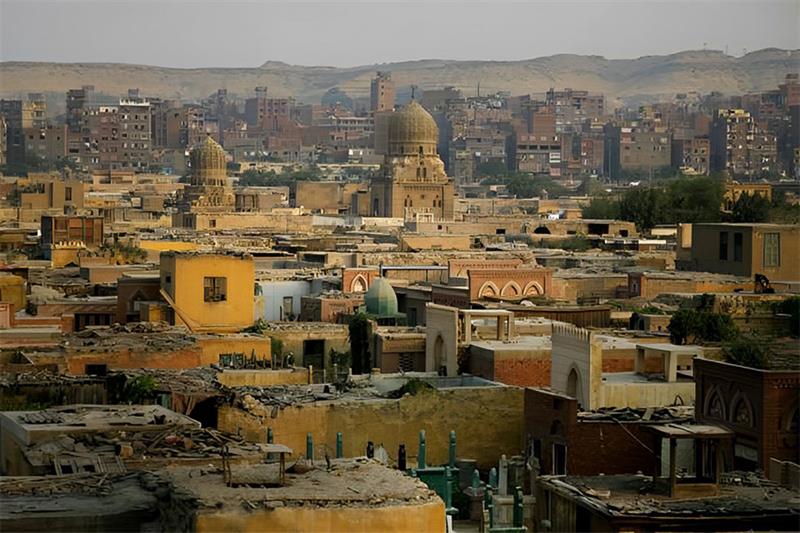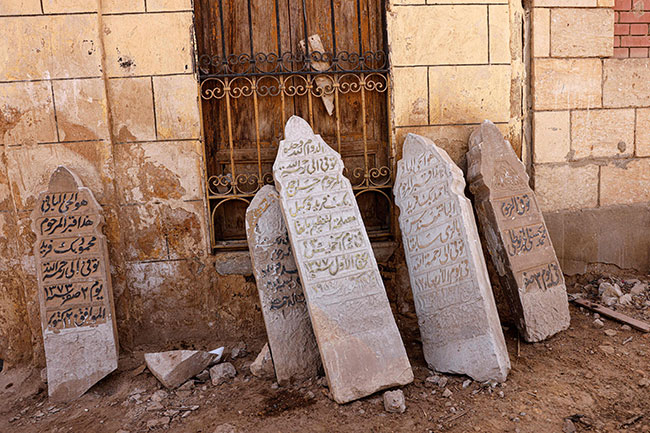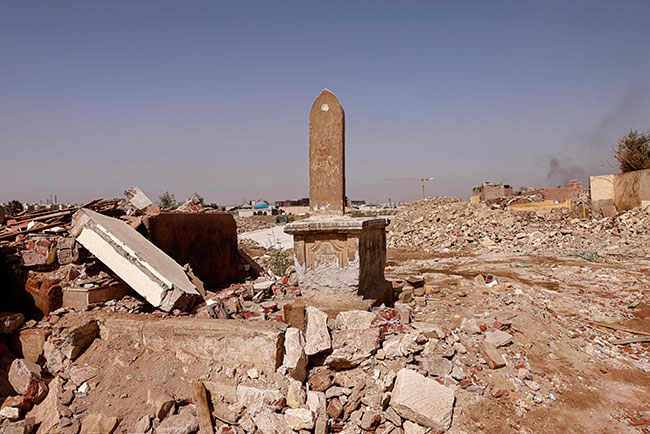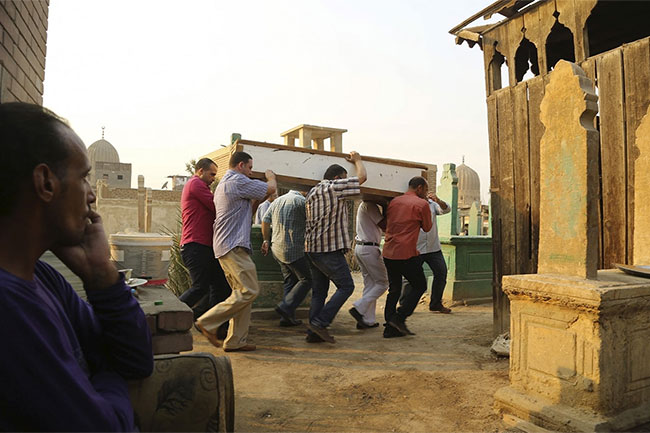Burying the dead and visiting their graves in Egypt: A rich history
Amira Noshokaty , Tuesday 20 Jun 2023
The new national cemetery, which is set to be a new burial ground for the most iconic figures of Egypt, heralds a new page in a rich history based on respect to those who left us and meticulous attention to details in visiting the places where their souls rest..

Last week, President Abdel-Fattah El-Sisi issued a decree directing the creation of a new national cemetery, The Tomb of the Immortals, to be the new burial ground for iconic figures in Egyptian history.
The moving of the remains of these iconic figures, along with the artistic and historic monuments at their current resting places, will be carried out by experts and specialists.
The new cemetery grounds will include a museum detailing the lives of these icons and their grand roles in the country's history.

The proposal to transfer the remains of iconic figures buried in Cairo's historic City of the Dead to a new site, which would be named Garden for the Immortals, had been circulating in the media for quite some time.
It was opposed by many of the descendants of these iconic figures on the grounds that their loved ones should continue to rest in peace where they are buried.
Some argued that what was needed in this 1,000-years-old unique cemetery town, home to priceless mausoleums as well as homes to generations of undertakers and descendants who lived side by side with the dead, was restoration and renovations to preserve the historic area plus turn it into a tourist site.
Guidebooks and Rules!
The Egyptian practice of paying detailed attention to rituals during visitation of cemeteries dates back to the Fatimid era (909-1171 AD).
Fatimid caliphs built lavish monuments to their ancestors and encouraged the general public to visit them by issuing guidebooks for cemetery tours.
They also issued guidebooks for cemetery visitors – Kutub Al-Ziyara (Books of Visitation), a practice that was only discontinued after the Ottoman invasion in the 16th century AD.
These guidebooks identified names and location of tombs and their historic importance and detailed rituals to be performed while visiting them.
The beginning - Not an end!
Some of Egypt's historic cemeteries started making headlines in 2020 after the Cairo governorate began demolition work on the outskirts of the City of the Dead to make way for new roads.
The City of the Dead is registered as part of Historic Cairo and is has been listed as a World Heritage Site held by UNESCO since 1979.
It stands as a testament to the continued hold of an Ancient Egyptian idea on the psyche of the country: Death is not the end - but rather a beginning.
Indeed, Ancient Egyptians spent much - if not most - of their lives preparing for the afterlife, as the country's antiquities testify to the world.
Egyptians continued to believe in the importance of preparing for the afterlife over the centuries while moving through major transformations in adopted religions from Christianity and Islam.
Today, Egyptian tombstones, courtyards and tombs themselves remain richly-decorated with Arabic calligraphy, artistic motifs and prayers for the salvation of the deceased.
With my loved ones!
During all major and minor religious holidays, many Egyptians choose to start celebrations by coming together with their lost loved ones.
Visitations to cemeteries include bringing flowers, as well as distributing special baked snacks (shuraik and orass) to undertakers and poorer residents in the City of the Dead in the capital and all other cities of the dead - big or small - elsewhere in the country.
Some people even spend one night or several nights in rest houses in family cemeteries to be close to the dearly departed.
Mausoleums of Fatimid nobles comprised sabils (public fountains) and kuttab (traditional Quranic schools) on their premises.
Even many Sufi sheikhs took up residence in cemeteries in Cairo and elsewhere in the country during their lives.
RIP means RIP!
The idea of reburying the dead or moving their remains from one place to another is widely detested and opposed by most in the general public.
Indeed, throughout history, Egyptians have never been anything but reluctant to move the remains of buried loves ones.
Amid this emotionally charged atmosphere, some citizens started an online initiative to petition the president to intervene to safeguard Cairo's historic cemeteries.
Those behind the initiative documented sites, raised awareness and submitted several alternate proposals to the government.
They organized a public seminar on heritage as well as an art and photo exhibition.
Cemeteries: All over
Historic cemeteries in Cairo stretch from the Moqattam Hill district to the Zeinhom district near Sayyeda Zeinab.
It covers six areas: Arafa, Sahra, Sayyida Nafisa, Bab El-Wazir, Bab El-Nasr and Zeinhom.
Arafa (spelled Qarafa but pronounced Arafa in colloquilal - and meaning graveyard) is the oldest of the six.
This area stretches between Fustat in the east and Moqattam in the west - with the outcrop of the historic Salahuddin's Citadel marking its northern border and the alluvial lake of Al-Habash (where Basatin is currently) marking its southern border.
The eastern section of Arafa - known as Al-Arafa Al-Sughra (The Little Graveyard) - is home to the 812-year-old famous Mausoleum of Al-Imam Al-Shafii (767-820 AD) - the founder of one of four main branches of Sunni Islamic jurisprudence followed by Muslims in Egypt.
This world-renowned mausoleum was built in 1211 AD during the Ayyubid period (1174-1250 AD).
Meanhile, the western section, known as Al-Aarafa Al-Kubra (The Big Arafa), is home to the Fatimid-era Jami Al-Qarafa (The Mosque of Arafa)
Over the years, Al-Arafa Al-Sughra expanded and grew in importance due to its proximity to the Salahuddin Citadel.
At Bab Al-Qarafa, more than ten Mamluk emirs, mostly linked to the Sultan Al-Nasir Muhammad, built their tombs in the 14th century.
These tombs came to be known as Al-Imamayn in the Ottoman and Muhammad Ali periods, after the two imams Al-Shafii and Al-Layth.

'A mountain like no other'
The use of Moqattam Mountain (which is really a hill but Cairenes like to call it a mountain!) for interring the dead dates back to the 7th Century AD at a the time of Amr Ibn Al-Aas negotiations for the handover of Egypt from the Byzantine ruler Muqawqis.
"The story goes that Muqawqis wanted to keep Moqattam Mountain under Byzantine rule because of its religious value - but Amr Ibn Al-Aas refused," said Professor of Antiquities at Ain Shams University Hossam Ismail.
The Byzantine Christians believed "It is said that when God picked a mountain upon which he shall reveal himself to Moses all other mountains donated some of their plants and flowers as tokens to the chosen mountain," Ismail explained.
"It was only Moqattam that donated all of its greenery to this mountain. So God rewarded Moqattam by making it the burial ground of those who shall go to heaven," added Ismail.
In any case, Amr Ibn Al-Aas took Egypt, built a new capital in Fustat in what is now the south of Cairo but started burying the Muslim dead in a cemetery at the foot of sacred hill.
This cemetery remains the final resting place of some Sahabis (Companions of Prophet Muhammad) such as Uqba Ibn Amr.
The Abbasids built more cemeteries in the Imam Al-Shafii and Sayyida Nafisa areas - also near the Citadel.
The Mamluk built more cemeteries in the Sayyida Aisha district in the south of Cairo, which became known as Arafat Al-Mamalik.

-- Sent from my Linux system.


No comments:
Post a Comment